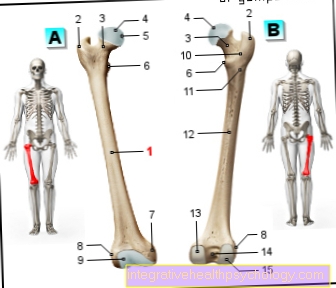The cost of a stomach reduction
Synonyms in the broader sense
Gastric surgery, gastric volume reduction, gastric banding, gastroplasty, sleeve gastric sleeve, Roux En Y bypass, small intestine bypass, gastric balloon
Medical: Bariatric Surgery
Introduction - the cost of a stomach reduction
Surgical stomach reduction is usually the last option for pathologically obese people to lose weight.
There are several different methods that can be used to reduce the size of the stomach. Since they differ in terms of effort and complexity, the costs also vary. In addition, these depend on the operation center and the services included.
Every form of stomach reduction also carries risks. If complications arise, the costs can rise significantly again.
If medically necessary, the costs for a stomach reduction can often be covered by the health insurance company upon request.
Alternatively, having the procedure carried out abroad is usually only cheaper at first glance and also involves additional risks.
At this point, it is recommended to first look at the main page for stomach reduction. For the most important information, read the following article: Stomach reduction - an overview of the most important things

What is the cost of a stomach reduction?
The costs for a stomach reduction mainly depend on the procedure chosen and the hospital where the procedure is performed and can therefore vary widely.
In addition, the actual cost of the treatment can never be precisely stated in advance. Due to the risks involved in a stomach reduction, complications can always arise. As a result, the costs can rise by several thousand euros.
When comparing the possible methods of stomach reduction without taking possible complications into account, in most cases the insertion of a gastric balloon is the best option. With this procedure, the only thing that needs to be done is a gastroscopy under twilight anesthesia instead of an operation under general anesthesia. Therefore, in contrast to the other types of stomach reduction, no inpatient stay is usually necessary, which also makes the lower costs understandable. Bringing in a gastric balloon costs around € 2,500 to € 3,000. This already includes the costs for the necessary removal of the balloon after about six months. This is also usually done through an outpatient gastroscopy.
When using a gastric band, however, the effort is significantly higher. The procedure requires an operation inside the abdominal cavity (usually with the "keyhole technique"), which requires general anesthesia and a three-day inpatient stay. Therefore, the costs for such an intervention are significantly higher at around 6,000 euros.
The so-called gastric bypass and the creation of a tubular stomach are even more complex and therefore more expensive. While the gastric band does not cut the organ itself, the gastric bypass surgery and gastric sleeve surgery surgically reduce the size of the organ. Correspondingly, seams are also required to securely close the stomach, which is more complex and demanding than, for example, the application of a gastric band from the outside. In addition, the risk of complications from such an operation is increased. Hence, these drastic and irreversible forms of stomach reduction are also the most expensive. Expect costs of at least € 8,000. However, these can easily reach into the five-digit range.
The individual methods of stomach reduction with the most important details can be found on the respective main pages:
- Gastric balloon for weight loss
- Stomach pacemaker - what's behind it?
- Gastric bypass costs
How do I get my stomach reduction coverage to be covered by health insurance?

None of the stomach reduction methods described above is yet among the standard benefit catalogs of the statutory health insurance companies. In order for the health insurance to cover the costs of a stomach reduction, certain requirements must be met. Most importantly, the procedure must be medically justified. This must be proven by a doctor.
The basis for this is that the patient is extremely overweight and the body mass index exceeds at least 35, possibly even 40.
In addition, there must be consequential damage associated with being overweight. These include, for example, joint diseases or metabolic diseases such as diabetes mellitus (“diabetes”).
In addition, all alternative measures for weight reduction, such as exercise programs and a change in diet, must already be exhausted.
The health insurance companies usually require proof of at least one medically controlled weight loss attempt, which has not been successful, before the cost of a stomach reduction can be covered.
If the prerequisites are met, a written application for assumption of costs must be submitted. The application process is often very time-consuming. This application is best formulated with the support of your doctor.
Most of the time, the health insurance company stipulates that the stomach reduction operation is carried out in an affiliated center. Here, the operated person receives follow-up care and, as part of the therapy, additional measures are taken in nutritional advice, in exercise centers and regular medical checks. These are represented by the departments of internal medicine, psychology, bariatric surgery and movement therapy.
The follow-up treatment takes place on average over a period of 6-12 months after the stomach reduction.
Stomach reduction by means of a gastric balloon is only approved after the insurance company has applied for the costs to be reimbursed if the balloon is used as part of a combination therapy, i.e. with subsequent surgery.
The costs for a gastric pacemaker are not covered by the health insurance.
In the case of private health insurance companies, none of the methods mentioned are also included in the catalog of rules for assuming the costs. Private patients would also have to submit an application for cost coverage.
Do you suffer from obesity and fear that you may have secondary diseases as a result? So you should take active action against obesity and undergo a medical examination. You can find everything you need to know about obesity at:
- Consequences of being overweight - what to watch out for
- Therapy of obesity in children and adolescents
What can I do if the health insurance company refuses to pay for the stomach reduction?
Very often it happens that the health insurance initially rejects the application to cover the costs of a stomach reduction or at least sets conditions that must be met before the costs are covered.
This is often the case even if the application is formulated in detail and with medical support and the requirements for the assumption of costs are formally given. Depending on the health insurance company and the case, certain aspects may not be recognized, in particular the exhaustion of all available measures for weight loss apart from an intervention.
Often, therefore, it is initially required that the patient take part in a professional fitness program for several weeks, if necessary seek psychological support and keep a food diary. Even if these measures are usually to be carried out over several months, it is advisable to implement them. On the one hand, there is the possibility of losing weight without the drastic intervention of a stomach reduction and on the other hand, if the measures fail, you will often be assured that the costs will be covered by health insurance.
Another possibility, if the application is rejected by the fund, is to file a written objection. With regard to the chances and possibility of an objection, the help of the family doctor can be used, for example.
If the reimbursement of costs is refused, it is not impossible to achieve the desired weight and thus regain health. Below you will find the most important information on how to best lose weight:
- Tips on how to best lose weight
- How can you boost fat burning?
Does the procedure abroad make sense due to the lower costs?
Because of the high cost of stomach reduction, some people travel abroad to have the procedure there. Several countries such as Turkey offer treatment at lower prices. In some cases, package prices including flight and transfer are even possible. Mostly not obvious at first glance, however, are the potential risks and possible additional costs involved in having a stomach reduction performed abroad.
On the one hand, the quality of treatment abroad is often not guaranteed, for example in terms of the training and experience of the surgical team.
Another important aspect is that a serious procedure such as stomach reduction requires lifelong follow-up care for the patient. Continuous professional support is necessary at least in the first few months and years. Although centers abroad usually also offer some form of follow-up care, this is usually by no means sufficient.
In addition, it must be taken into account that stomach reduction is always associated with risks and that complications or difficulties can arise for a long time as a result of the procedure and after the procedure. This aspect is relevant in several ways when considering having a stomach reduction performed abroad.
These complications include, for example, inflammation that can occur during the operation itself or afterwards during the stay. The result is a longer hospital stay and additional medical treatment for the complication that becomes necessary. This can result in enormous additional costs, which then usually have to be borne by the patient himself.
Overall, the procedure quickly becomes more expensive than if it had been carried out in Germany.
The second aspect that has to be considered with regard to possible complications and consequential damages is that if they do occur, it is best to go to the hospital where you were treated. For patients who have had the stomach reduction performed abroad, this is usually not easily possible.
For the reasons mentioned, no recommendation can be made to go abroad for the procedure.
The costs are often only lower at first glance and you don't get the necessary long-term support.
In addition, the health insurance company can only cover the costs if the procedure is carried out in Germany.





























